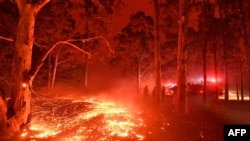Young researchers and students are competing in a disaster challenge at a natural hazards forum in the Australian city of Brisbane.
The government-funded organization Natural Hazards Research Australia has said more Australians "than ever before are exposed to the damage and destruction of floods, bushfires, cyclones, heatwaves and storms."
It reported that Australia has experienced 28 disasters that have cost more than $630 million, and 16 of these have occurred since 2000.
Experts have said that research is essential to improve Australia's readiness for natural calamities.
At the inaugural Natural Hazards Research Forum in Brisbane, young researchers have been asked to solve a key conundrum in preparing communities for floods, fires and storms; how can disaster authorities get potentially life-saving advice to the "unengaged, the moving," such as tourists or "the hard to reach"?
The winning entry aims to reach international tourists through Wi-Fi — essentially captive portals that compel visitors in flood or fires zones, for example, to watch a survival video before they can log onto the Internet at hotels, cafes or other destinations.
Mark Owens from the Country Fire Authority, an emergency service in the Australians state of Victoria, told VOA that the videos would be tailored for various locations and seasons.
"Making sure the message we actually get to them will actually change their behavior but also get them to do that for the future again and again, and that is why the videos will be tailored and changed seasonally, or, you know, if there is a La Niña coming through again,” he said. “So, you know, it might then really focus on floods for a big period of time instead of bushfire."
Parts of Victoria state are currently facing one of the biggest floods in decades.
There have been rescues and evacuations along the Maribyrnong River in the city of Melbourne.
Thousands of people are also under evacuation orders for flooding in the states of New South Wales and Tasmania.
Two climatic phenomena — La Niña and the Indian Ocean Dipole — are fueling the flooding. Both occur naturally and are influenced by warmer ocean temperatures. They are dumping above-average rainfall across much of Australia, and experts say they are being super-charged by climate change.
Sydney is having its wettest year on record. More than 2 meters of rain have fallen on Australia's biggest city, breaking the previous record set in 1950.







